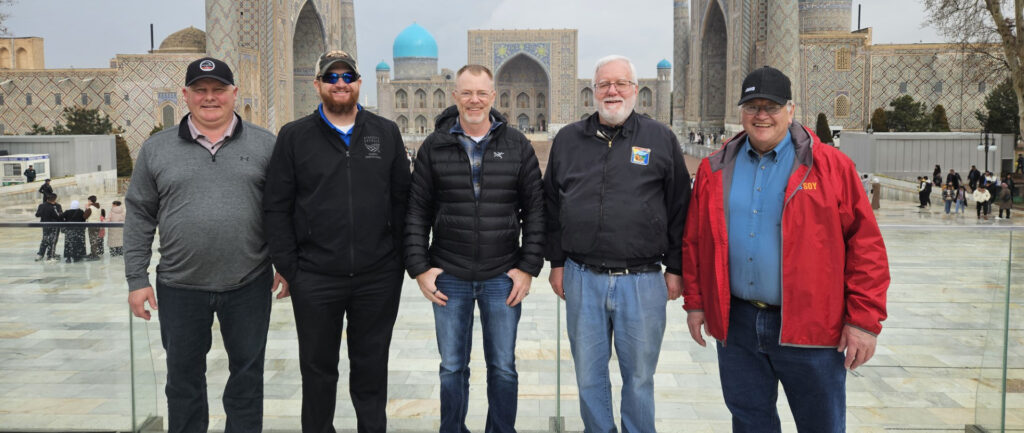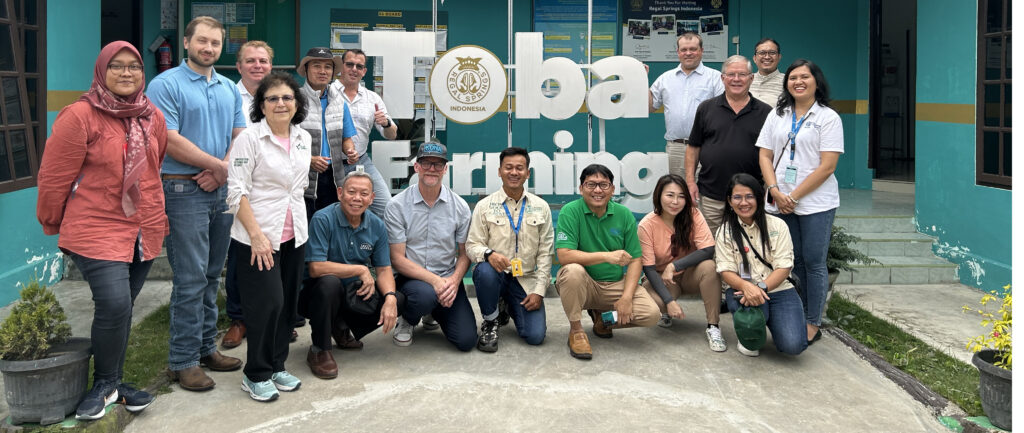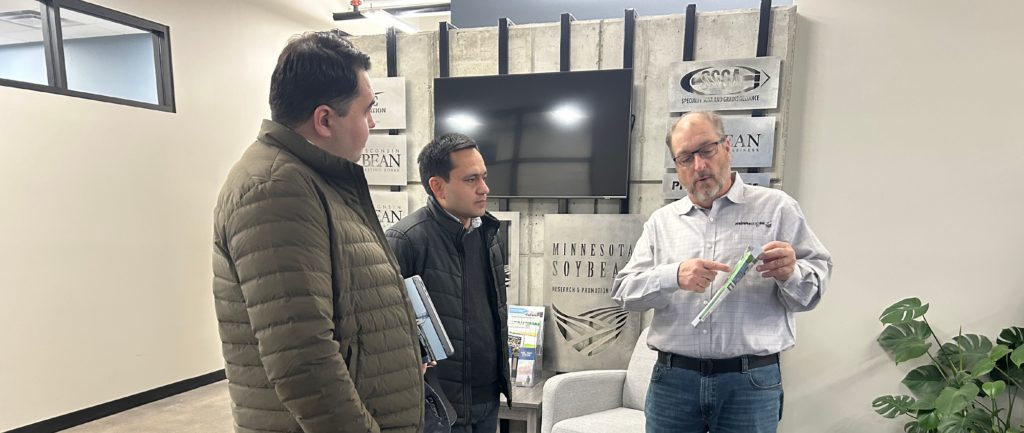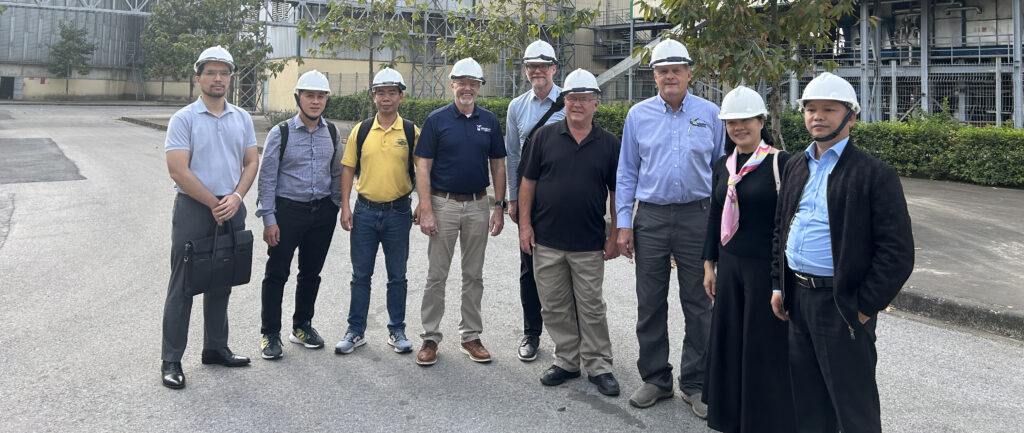Minnesota Soybean experienced a closer look at the burgeoning shipping opportunities at the Port of Duluth-Superior during a visit with four Moroccan buyers as part of a trade mission led by the U.S. Soybean Export Council. The trip came on the heels of a fall 2022 trade mission to Morocco with the Minnesota Department of Agriculture (MDA) and Minnesota Soybean Growers Association (MSGA) Executive Director Joe Smentek.
“This was a great opportunity to visit with Moroccan leaders and see how we can get U.S. soybean meal and soybeans over to Morocco,” Smentek said.
As part of the tour, Smentek and Kim Nill, director of market development with the Minnesota Soybean Research & Promotion Council (MSR&PC), visited the Hansen-Mueller Elevator in Duluth.
“You’re seeing history here,” Facility Manager Jeff Blaskowski said of Hansen-Mueller, which acquired the facility in 2022 after several years of vacancies. “This is a cool, old elevator.”
The Hansen-Mueller facility can store 3.5 million bushels of grain and stands 195 feet above the bar. The site also supports nine legs and has a nearly 2,000-foot dock and on-dock rail service from BNSF Railway. The facility was built in the late 1800s – “You’re not going to see a lot of automation here – yet,” Blaskowski said – and can export small grains, plus soybeans and meal, from the United States and Canada to both domestic and international customers.
“It was interesting to visit this terminal and learn more about the investments that Hansen-Mueller is making here in Minnesota to increase our ag exports,” said Andrea Vaubel, deputy commissioner of MDA.
Following the Hansen-Mueller visit, the delegation, which included buyers from Morocco’s feed milling industry, toured the Port of Duluth-Superior.

“Morocco is of special interest because their ports are smaller than the huge ports in other nations, so they would benefit from having shipments directly from Duluth in seaway max vessels, which are ideal to import Minnesota soy,” Nill said.
Though the port still ships about a million tons of grain annually – wheat and beet pulp pellets are some of the top exported commodities – iron ore is far and away the most popular material exported from the Port of Duluth-Superior, which first opened for commercial shipping over 150 years ago. The port is the continent’s furthest inland seaport and the highest-ranking port on the Great Lakes, attracting about 900 vessels each year. Shippers prefer shipping via Duluth-Superior partly because traffic is uncongested; traffic on the Seaway could double and ships and barges would still flow freely.
“The great thing about the Great Lakes is we can offer a diversified supply chain for many of these shippers utilizing the coast,” said Kate Ferguson, director of trade and business development with the Duluth Seaway Port Authority. “So many companies want to diversify their risks, and we know the Great Lakes can be a reliable chain.”
Grain shipments at the port dipped by 20% in 2022, the port’s smallest grain throughput since 1890. The port hasn’t moved soybeans in about five years, and overall grain exports could drop again in 2023.
“We’re all trying to support agriculture throughout our region to get products to market,” Ferguson said.
MSGA and MSR&PC are eager to continue promoting the Great Lakes St. Lawrence Seaway System through checkoff projects and legislative activities.
“This system could be a big deal for our farmers,” Smentek said. “We just need Hansen-Mueller to keep going and build excitement so eventually we can connect the Port of Duluth with buyers in Europe, North Africa and Central Asia.”
Morocco is Africa’s fourth-largest economy, with a growing population (37 million) that continues prioritizing animal agriculture. All U.S. imports to Morocco are duty-free following the United States-Morocco Free Trade Agreement (FTA). Morocco is the largest importer of soybean meal in the Middle East and North Africa and one of the top 15 importers of U.S. soybean meal. Because Morocco has no crushing facilities, feed mills import all ingredients, including soymeal. According to Soy Stats, Morocco imported $153 million in U.S. soymeal in 2022, making it the ninth largest market. It has the largest compound feed production in Maghreb markets, and U.S. soy farmers have collaborated with Morocco since 1995.
“With opportunities to now ship from Duluth, we heard lots of excitement about sourcing ingredients from Minnesota,” Smentek said. “The majority of their soymeal comes from the U.S., but all three (feed mills) in the country are growing and looking to diversify their supply chains.”
Smentek also explained how the expansion of soybean crush plants throughout Minnesota, the Midwest and U.S. makes Minnesota soybeans an attractive, affordable option for international customers.
“Hansen-Mueller will transload from any of these facilities,” he said. “It should be relatively easy on the rail system to get soybeans.”
Khalid Benabdeljelil, USSEC’s representative in Morocco, said his group was impressed by the reliability and magnitude of the Port of Duluth.
“This is the first time we’ve gotten to do something like this,” said Benabdeljelil, who graduated from the University of Minnesota. “They’re really trying to diversify here, and we see possibilities for shipping soy meal from (Duluth). It’s been a very positive experience.”
During their final day in Minnesota, the Moroccan team visited Cargill’s and CHS’ facilities before meeting with MDA Commissioner Thom Petersen in St. Paul. Petersen told buyers how MDA addresses and prevents animal diseases, and promotes soil health practices through the popular Minnesota Agricultural Water Quality Certification Program. MDA hopes to continue to build the relationship with Morocco by returning with a trade team in early 2024.
“We’re really glad you took time to visit Minnesota,” MDA Commissioner Thom Petersen said. “We’re very interested in the Port of Duluth and the opportunities there.”







